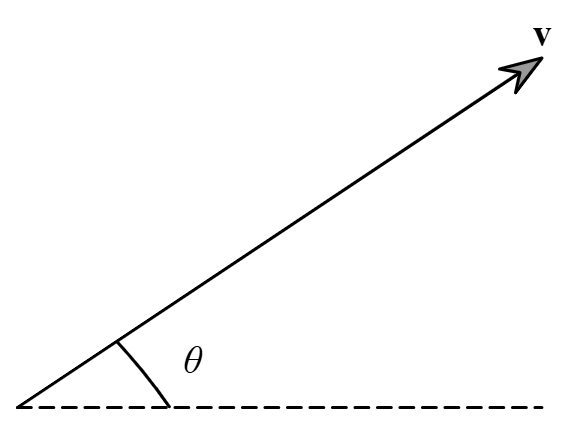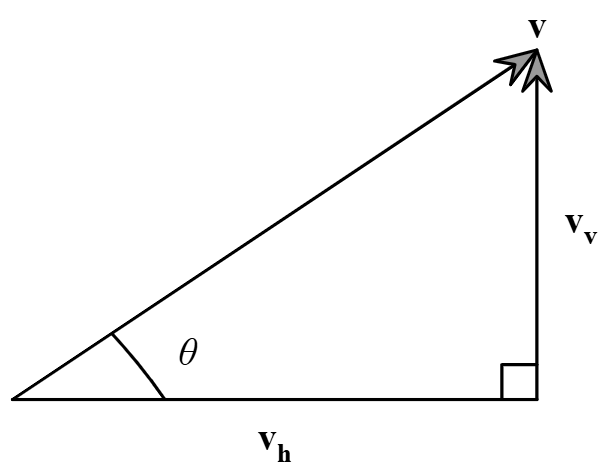Cartesian Vectors
Cartesian Vectors are the components of a resolved (or decomposed) Geometric Vector along orthogonal axes whose sum are the given vector. They are classified as such since their endpoints can be defined using Cartesian coordinates.
Cartesian Vectors are expressed as \(\vec{v}=\langle{\vec{v}_h, \vec{v}_v\rangle}\) or \(\vec{v}=\langle{\vec{v}_x, \vec{v}_y\rangle}\).
Consider a vector \(\vec{v}\) at an angle of \(\theta\) to the horizontal. It can be resolved into rectangular components \(\vec{v}_h\) (horizontal component) and \(\vec{v}_v\) (vertical component) where \(\vec{v} = \vec{v}_h + \vec{v}\).
Let’s look at vector \(\vec{v}\) for reference:

Vector \(\vec{v}\) can be broken down into its horizontal and vertical components as such:

The magnitude for the horizontal component of a vector can be calculated using the following formula:
\(|\vec{v}_h = |\vec{v}|\cos\theta|\)
The magnitude for the vertical component of a vector can be calculated using the following formula:
\(|\vec{v}_v = |\vec{v}|\sin\theta|\)
ExampleConvert each geometric vector to a cartesian vector:
- \(|\vec{v}|=180\) at \(30^{\circ}\) to the horizontal
- \(|\vec{u}| = 50\) at \(15^{\circ}\) to the vertical
i. First, we can determine that magnitude of \(\vec{v} = 180\) and \(\theta = 30^{\circ}\).
Next, we can calculate the rectangular components.
We can first determine the horizontal component:
\(\vec{v}_x = |\vec{v}|\cos\theta\)
\(\vec{v}_x = 180\cos(30^{\circ})\)
\(\vec{v}_x \approx 155.88\)
We can then determine the vertical component:
\(\vec{v}_y = |\vec{v}|\sin\theta\)
\(\vec{v}_y = 180\sin(30^{\circ})\)
\(\vec{v}_y = 90\)
Finally, we can write the Cartesian Vector as such:
\(\vec{v} = \langle{\vec{v}_x, \vec{v}_y \rangle}\)
\(\vec{v} = \langle{155.88, 90 \rangle}\)
Therefore, we can determine the Cartesian Vector of \(\vec{v}\) is \(\boldsymbol{\langle{155.88, 90 \rangle}}\).
ii. First, we can determine that magnitude of \(\vec{u} = 50\) and \(\theta = 75^{\circ}\).
Next, we can calculate the rectangular components.
We can first determine the horizontal component:
\(\vec{u}_x = |\vec{u}|\cos\theta\)
\(\vec{u}_x = 50\cos(75^{\circ})\)
\(\vec{u}_x \approx 12.94\)
We can then determine the vertical component:
\(\vec{u}_y = |\vec{u}|\sin\theta\)
\(\vec{u}_y = 50\sin(75^{\circ})\)
\(\vec{u}_y \approx 48.3\)
Finally, we can write the Cartesian Vector as such:
\(\vec{u} = \langle{\vec{u}_x, \vec{u}_y \rangle}\)
\(\vec{u} = \langle{12.94, 48.3 \rangle}\)
Therefore, we can determine the Cartesian Vector of \(\vec{u}\) is \(\boldsymbol{\langle{12.94, 48.3 \rangle}}\).
\(|\vec{v}| = 17.5\) at \(60^{\circ}\) below the horizontal
First, we can determine that magnitude of \(\vec{u} = 17.5\) and \(\theta = 60^{\circ}\).
Next, we can calculate the rectangular components.
We can first determine the horizontal component:
\(\vec{v}_x = |\vec{v}|\cos\theta\)
\(\vec{v}_x = 17.5\cos(60^{\circ})\)
\(\vec{v}_x \approx 8.75\)
We can then determine the vertical component:
\(\vec{v}_y = |\vec{u}|\sin\theta\)
\(\vec{v}_y = 17.5\sin(60^{\circ})\)
\(\vec{v}_y \approx 15.16\)
Finally, we can write the Cartesian Vector as such:
\(\vec{v} = \langle{\vec{u}_x, \vec{u}_y \rangle}\)
\(\vec{v} = \langle{8.75, 15.16 \rangle}\)
Therefore, we can determine the Cartesian Vector of \(\vec{v}\) is \(\boldsymbol{\langle{8.75, 15.16 \rangle}}\).
\(|\vec{u}| = 276\) at \(40.5^{\circ}\) to the vertical
First, we can determine that magnitude of \(\vec{u} = 276\) and \(\theta = 49.5^{\circ}\).
Next, we can calculate the rectangular components.
We can first determine the horizontal component:
\(\vec{u}_x = |\vec{u}|\cos\theta\)
\(\vec{u}_x = 276\cos(49.5^{\circ})\)
\(\vec{u}_x \approx 179.25\)
We can then determine the vertical component:
\(\vec{u}_y = |\vec{u}|\sin\theta\)
\(\vec{u}_y = 276\sin(49.5^{\circ})\)
\(\vec{u}_y \approx 209.87\)
Finally, we can write the Cartesian Vector as such:
\(\vec{u} = \langle{\vec{u}_x, \vec{u}_y \rangle}\)
\(\vec{u} = \langle{179.25, 209.87 \rangle}\)
Therefore, we can determine the Cartesian Vector of \(\vec{u}\) is \(\boldsymbol{\langle{179.25, 209.87 \rangle}}\).
Magnitude of a Vector
To find the magnitude of a vector, you can use the formula for the distance between two points:
\(|\vec{P_1, P_2}| = \sqrt{(x_2 - x_1)^2 + (y_2 - y_1)^2}\)
- \(P_1\) represents the first point
- \(P_2\) represents the second point
- \(x_1\) represents the \(x\)-coordinate of \(P_1\)
- \(x_2\) represents the \(x\)-coordinate of \(P_2\)
- \(y_1\) represents the \(y\)-coordinate of \(P_1\)
- \(y_2\) represents the \(y\)-coordinate of \(P_2\)
Example
Determine the magnitude for vector \(\vec{AB}\) with coordinates \(A(6, 2)\) and \(B(3, 4)\).
We can determine the magnitude by plugging the appropriate values into the corresponding formula and solving. In this instance, \(A\) represents the first coordinate and \(B\) represents the second coordinate:
\(|\vec{AB}| = \sqrt{(x_2 - x_1)^2 + (y_2 - y_1)^2}\)
\(|\vec{AB}| = \sqrt{(3 - 6)^2 + (4 - 2)^2}\)
\(|\vec{AB}| = \sqrt{(-3)^2 + (2)^2}\)
\(|\vec{AB}| = \sqrt{13}\)
Therefore, we can determine that the magnitude of \(\vec{AB}\) is \(\boldsymbol{\sqrt{13}}\).
\(\vec{MN}\) for \(M(-9, 4), N(0, 8)\)
We can determine the magnitude by plugging the appropriate values into the corresponding formula and solving. In this instance, \(M\) represents the first coordinate and \(N\) represents the second coordinate:
\(|\vec{MN}| = \sqrt{(x_2 - x_1)^2 + (y_2 - y_1)^2}\)
\(|\vec{MN}| = \sqrt{(0 - (-9))^2 + (8 - 4)^2}\)
\(|\vec{MN}| = \sqrt{(9)^2 + (4)^2}\)
\(|\vec{MN}| = \sqrt{97}\)
Therefore, we can determine that the magnitude of \(\vec{AB}\) is \(\boldsymbol{\sqrt{97}}\).
\(\vec{RS}\) for \(R(1, -6), S(-5, 2)\)
We can determine the magnitude by plugging the appropriate values into the corresponding formula and solving. In this instance, \(M\) represents the first coordinate and \(N\) represents the second coordinate:
\(|\vec{RS}| = \sqrt{(x_2 - x_1)^2 + (y_2 - y_1)^2}\)
\(|\vec{RS}| = \sqrt{(-5 - 1)^2 + (2 - (-6))^2}\)
\(|\vec{RS}| = \sqrt{(-6)^2 + (8)^2}\)
\(|\vec{RS}| = \sqrt{100} = 10\)
Therefore, we can determine that the magnitude of \(\vec{RS}\) is \(\boldsymbol{10}\).